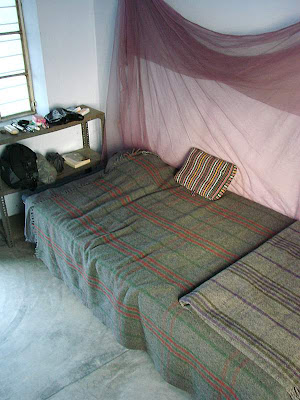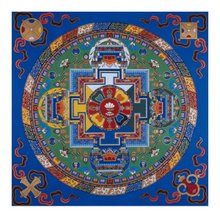Last year at this time I attended my first course in Vipassana meditation as taught by Burmese-Indian guru S.N. Goenka. Like then, I was in India principally because I had to leave Nepal for a few weeks between visas. Having benefited from last year's 10-day, I decided to do another in Sarnath, sight of the Buddha's first teaching.
FACILITY
Overall the center is adequate to the needs of meditators, who sitting for 10 of their waking hours require only the most basic necessities. The two male dormitories are square concrete buildings with rooms lining a central courtyard. One courtyard was planted with a small flower garden, the other was concrete and used principally for hanging laundry. Rooms are sparse - concrete floors, iron-legged beds supporting comfortably stuffed mattresses, a mosquito net and one iron shelf (slightly rusted) for personal items. Bedding includes a mattress, pillow, sheet, pillow case, and in winter wool blanket. Additional blankets are available on request. Windows are screened to keep out India's teeming population of mosquitoes. A few rooms have attached bathrooms that include toilets and a bathing space (and seem to be the areas throughout the facility most in need of thorough cleansing). Hot water is provided in the winter season through a communal cauldron (over a fire pit) from which meditators may fill their bathing buckets. Laundry is done by hand in the same buckets.



The dining hall is similarly functional, outfitted with plastic stools on which meditators sit facing the walls, eating meals from their stainless steel trays, bowls, plates and cutlery, which they wash afterwards in a long sink just next to the dining area.

The Dhamma Hall, where meditators spend most their waking hours, is a circular concrete structure with plenty of windows to take in natural light, a thin carpet, two sets of two seats for teachers, and two televisions for presentation of taped discourses on meditation techniques and philosophy.


A smaller Dhamma Hall similar in appointment but square in construction was used during my retreat by the non-Indian participants for viewing English versions of the evening video discourses. I made private use of this room for meditation when the main Dhamma Hall or the residence became too distracting, about which you can read more here.
A large vegetable garden, from which we were fed during our stay, makes up the central courtyard of the center, which also includes a lovely rose garden in front of the Dhamma Hall. Many meditators spent free hours circumambulating the paved walkway circling the vegetable garden and linking the male residences with the dining hall and Dhamma hall.

MEALS
The first couple of days didn't impress, but the quality of the meals seemed to improve during the length of the course (or I simply started getting used to the cooking). Food was typical Indian fare and most often consisted at lunches of dahl, curried vegetables, slices of raw vegetable (mostly carrot and radish), white rice and rotti. On occasion curd was available. Breakfasts were usually porridge of some type plus a curried vegetable; masala chai and hot milk were served on alternate days. Evening snacks for new students was a bowl of puffed, curried rice and masala tea; older students were served hot lemon water.

ENVIRONMENT
The center is located several kilometers from Sarnath proper in an agricultural village. The nearest home seems to be some hundred meters distant. Still, Indians like things loud, and so it was possible on more than one occasion to hear televisions, stereos, and parties, though hardly at the level where they disturbed sleep. There were no foul odors or air pollutants.
MANAGEMENT
Apart from issues related to the teacher's handling of the students, I had no problems with the staff. Most of them seemed to have only rudimentary English skills and so to avoid confusion meditators were asked to write requests on a pad kept outside the dining hall. I later learned that things were not as comfortable on the female side. For more about both these issues, see here.

Overall, the Sarnath facility meets the basic requirements for meditators; except for its gardens it doesn't go out of its way to make visitors comfortable. Should you believe in energy emanations of sacred sites, the location may be an added incentive to attend a course here. Otherwise, you might like to look to more well appointed centers where you share a language and cultural assumptions with the volunteer workers.
#



























I'm curious as to how you took pictures inside the center? Were they cool with that?
ReplyDeleteNo problem ay all. I took these on Day 10, after the end of Noble Silence, and on the morning of the 11th.
ReplyDeleteyour info about the sarnath vipassana is very helpful to me as i am going for this course for the 1st time.
ReplyDeletethanks for sharing the snaps of the center,it helped me break my prejudice.
Thanks for the review, I'll skip Sarnath. The food, accomodation, environment at Igatpuri was much better..
ReplyDelete